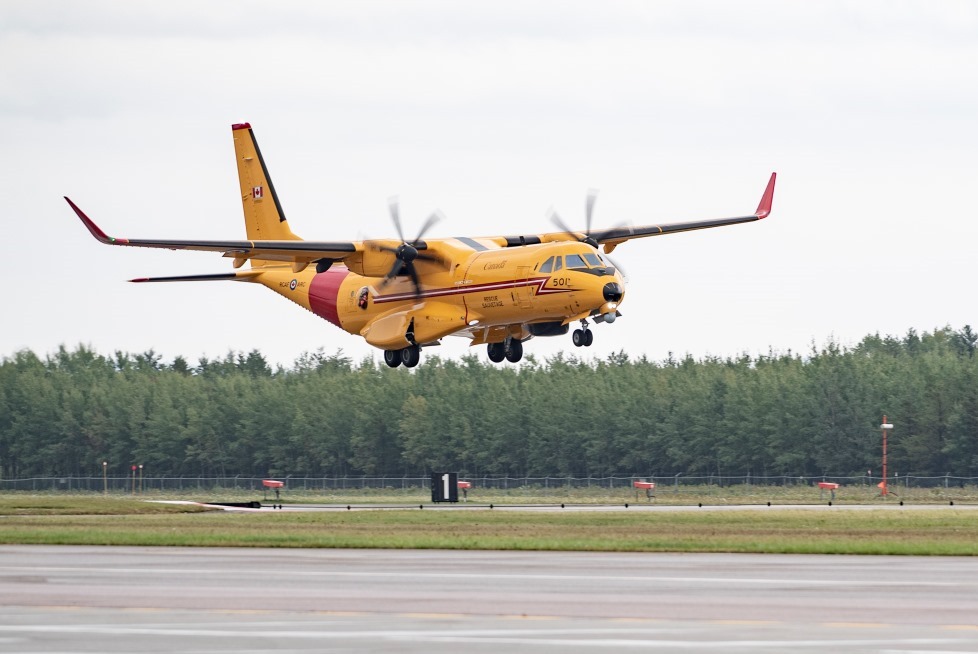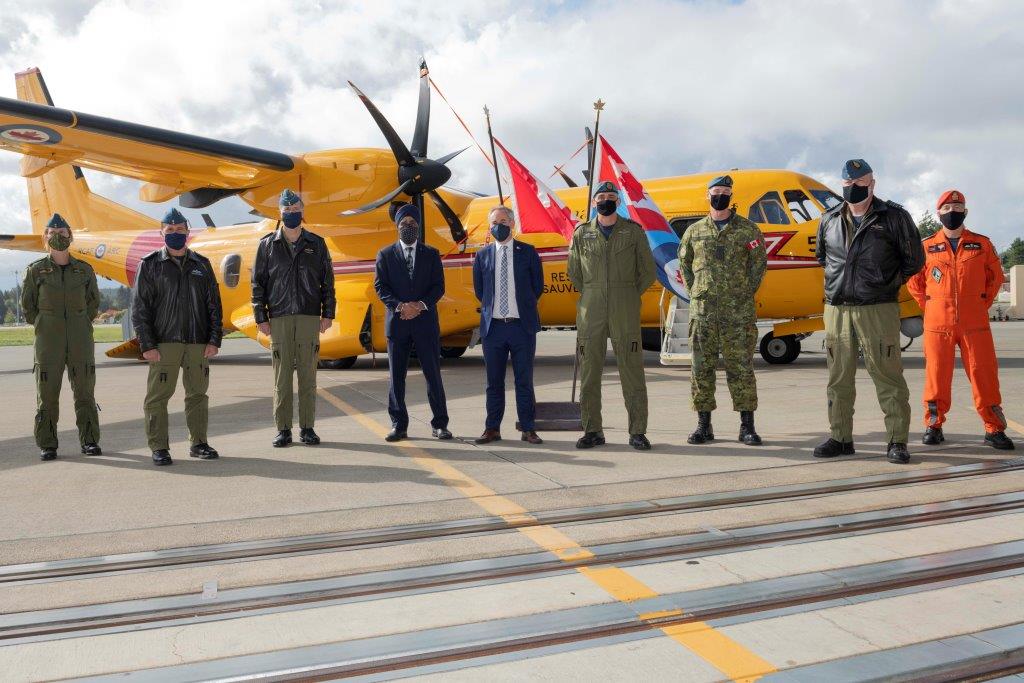KINGFISHER JOING THE FLOCK
KINGFISHER JOINS
RCAF FLOCK
CDR recently sent Aviation Editor, Joetey Attariwala, to CFB Comox for the arrival of the first Airbus CC-295 Fixed-Wing Search and Rescue (FWSAR) aircraft, now formally known as the Kingfisher, in the Royal Canadian Air Force (RCAF). Here is our report.
 The Kingfisher name extends the avian theme that already exists in the RCAF’s search and rescue community with the CH-149 Cormorant and, by the way, it beats out four other shortlisted contenders including Canso II, Guardian, Iris and Turnstone.
The Kingfisher name extends the avian theme that already exists in the RCAF’s search and rescue community with the CH-149 Cormorant and, by the way, it beats out four other shortlisted contenders including Canso II, Guardian, Iris and Turnstone.
According to the military, Kingfishers are found all across Canada and are recognized for their speed and agility, as well as having keen searching and hunting skills. Therefore Kingfisher represents the ability of RCAF search and rescue (SAR) crews to accomplish their life saving tasks. The new fleet of CC-295 Kingfishers will ultimately replace the CC-115 Buffalo and CC-130H Hercules aircraft which are currently tasked with the role of fixed-wing SAR in Canada.
As well as CFB Comox, Kingfisher will also be based at CFBs Winnipeg, Trenton and Greenwood. Back in December, 2016, Canada announced the selection of the Airbus C295W for its FWSAR requirement and the $2.4 billion contract calls for the procurement of 16 aircraft, plus training and In-Service Support elements, including the construction of a new training centre in Comox.
Canada’s Industrial and Technological Benefits (ITB) Policy will ensure that Airbus Defense and Space invests an amount equal to the value of the contract in the Canadian economy. High-value jobs will continue to be generated from the contract with Canadian companies such as PAL Aerospace, Pratt and Whitney Canada, CAE, and AirPro.
Aircraft 295501 was formally accepted by Canada in Spain on 18 December 2019. The 501’s arrival in Comox marks the first fully mission-configured CC-295 in Canada, and it represents a transformational change in capability for RCAF. Unlike the Buffalo and Hercules, the Kingfisher aircraft are fitted with advanced sensors including an L3Harris WESCAM MX-15 electro-optical and infrared (EO/IR) system, ELTA Systems surveillance radar, Automatic Identification System (AIS) and more.
All of which finally brings SAR in the Canadian Armed Forces into the 21st century. Jorge Tamarit Degenhardt, Head of FWSAR C295 Program at Airbus Defence and Space, spoke about some of the unique aspects of the CC-295 said, “We have invested close to one million man hours of engineering in developing the FWSAR version, so as you can imagine we have modified almost all the systems in the aircraft and we have brought the C295 to the next level. One of the main modifications we have done is related to the aerodynamic performance of the machine. One of the challenges we had was to bring the C295 farther and faster so the Air Force is able to cope with the Search and rescue missions in remote regions within Canada.”
He added, “We have integrated the Collins Pro Line Fusion avionics into the C295. There are larger tactile displays with loads of information on it. We have terrain awareness and warning system information, overlaid weather radar information, and we have a synthetic vision system through the EVS cameras in the front of the aircraft which can be displayed in the cockpit. The C295 is an amazing platform for Canada - we made it smarter, we made it faster and it flies even farther.”
DELIVERING 6 AIRCRAFT THIS YEAR
At the ceremony, Dirk Hoke, CEO of Airbus Defence and Space, commented via video, “We are very proud to deliver this great aircraft to Canada. It has been a very challenging time, especially now in the last six months due to COVID-19 impact, and we are very proud that the client together with us overcame all these challenges and were able to deliver this aircraft. It is also still a challenge because we want to deliver by the end of the year 6 aircraft out of the 16, and we’re very confident that this will be achieved.”
The Honourable Harjit Sajjan, Minister of National Defence, presided over the arrival and naming ceremony AND COMMENTED, “We are acutely aware of the lifesaving work of our search and rescue community… Emergency Management BC recorded a record breaking 333 SAR related events in July alone, and the Canadian Armed Forces and the Canadian Coast Guard members have received more than 7,000 calls across the country just this year. So there is no doubt that the skills and expertise that you offer as members of the Air Force are critical to Team Canada’s search and rescue response.”
He added, “… last year that we reactivated 418 Squadron as a search and rescue operational training squadron to become the heart of the search and rescue centre of excellence right here at 19 Wing. Today, I am pleased to join you in marking an exciting milestone, the arrival of the first CC-295 Fixed-Wing Search and Rescue aircraft. This is the first of 16 new aircraft that will eventually replace the existing fixed-wing search and rescue fleet…. with the entire fleet delivered by the end of 2022.”
Lieutenant-General Al Meinzinger, Commander of the Royal Canadian Air Force said, “The venerable Buff and Hercules have served us well over the past decades. As we look to the future, the capabilities that this aircraft will bring, as Minister Sajjan has already mentioned, will further enhance our aviators’ ability to carry out their SAR mission. The transition to the new Fixed-Wing SAR fleet is a tremendous opportunity for the RCAF, and will take a great deal of dedication, precision and focus. We’re moving from two fleets of aircraft to one common fleet, all the while having to maintain the continued level of SAR service here in Canada - this is an awesome task. As some of you may recall, we reformed 418 Squadron here [CFB Comox] about a year ago, this will be the aircraft’s initial home station, and of course 418 Squadron will become the center of excellence for SAR training here in Canada.”
Part of this FWSAR Project includes the construction of a new training centre in Comox which will be used to train both maintenance and aircrews. Built by Canadian training leader and systems integrator CAE, the centre includes ten classrooms, as well as sophisticated training devices such as a full-flight simulator, a cockpit procedures trainer, a sensor station simulator, and an aircraft maintenance trainer.
CAE TO OPERATE SAR TRAINING CENTRE
France Hébert, Vice-President and General Manager Canada Region at CAE, told CDR, “We at CAE have a big part of this program which is so important for Canada. We have the training centre and we have the training devices - very innovative training devices like the latest in virtual reality technology. I’m very impressed at the advances in technology that we’re offering and how we get to train the maintainers and the operators in the Canadian Forces now - it’s fantastic!”
Hébert added, “We’re currently training the trainers, and we expect to start initial cadre training in the next month or so. CAE is a Canadian company as you know, but we sell globally, so this is something that we will be able to leverage in our global exports to other militaries around the world.”
Philip Garbutt, Senior Vice-President, Global Support at PAL, told CDR, “I, as ex-military, have been waiting for this moment since 1995 when I used to serve at 442 Squadron. The retirement date for the Buffalo was 1995, believe it or not, so here we are some years later finally seeing the first of the 295s arrive. It’s a proud moment for the Air Force, and particularly proud for PAL given what we see as a very important role as a joint venture partner with Airbus on this program, but also as the providers of In-Service Support with the Air Force.”
Garbutt added, “It’s a beautiful piece of kit and we are really excited to support the operational test and evaluation which will start relatively soon, and then into full ops. You’re aware that PAL has been considered as a maritime/Newfoundland-based company, but I think we have dispelled that because we are most definitely a world-wide company.”
He explained, “From a Canadian perspective, as we stand up each of the main operating bases for the CC-295 - here in Comox, Trenton, Greenwood, and then Winnipeg - it spreads us out which will give us a national level footprint which stretches from the very Western tip of the country to the very Eastern tip, and we also spend a lot of time up North.”
INSIDE THE CC-295
CDR was afforded a tour inside the new CC-295 and our initial impression is positive. The aircraft is fitted with numerous racks for SAR equipment which means space is at a premium, however the mission consoles are a game-changer for Canada’s FWSAR fleet and will undoubtedly save considerable time in the search phase of an SAR mission.
Interestingly, the CC-295 has all fuselage windows removed, with the exception for large bubble windows at the rear of the aircraft and a small window on an escape hatch on the port side at front of the aircraft. This makes the interior of the CC-295 quite dark without lighting engaged, however this would help sensor operators visualize their screens without the risk of glare. Extra seating on the CC-295 is at a premium with room for only two persons in the “crew quarters” area, which is adjacent to a small galley and lavatory near the front of the aircraft.
From an exterior perspective, the aircraft is sleek and the yellow SAR livery dramatic but I personally feel the “Canada” stencils and RCAF roundels on either side of the fuselage are unusually small. This may be a nit-picky observation, but the CC-295 is the premier SAR aircraft for Canada, so I’m somewhat mystified as to why these sentinels are not as prominent as they perhaps should be.
Having said that, CDR will continue to follow the operational test and evaluation phase and will be reporting on the CC-295 beginning SAR missions in a future issue of the magazine.
Welcome to the fleet, Kingfisher!
Joetey Attariwala is CDR’s Senior Staff Writer and Aviation Editor.

